Osprey
Books Recommendation |
||
|
|
|
|
Osprey
Books Recommendation |
||
|
|
|
|
| Men at Arms Series | ||||
Frontpage |
Description/contents |
Author |
Publisher |
Buy from |
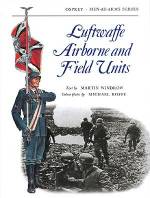 |
Men at
Arms 22 Luftwaffe airborne and field units This book explores the uniforms, equipment, history and organization of Germany’s World War 2 air arm. Parachutists and the ‘Hermann Goring’ division are amongst the specialists covered. Uniforms are shown in full color artwork. |
Martin Windrow |
||
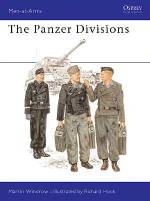 |
Men at
Arms 24 The Panzer divisions For the first three years of the Second World War the German Army's armored formations dominated the world's battlefields. During this period the Panzerwaffe swept away all that was before them, achieving victories over numerically superior and sometimes better equipped opponents. This remarkable book by Martin Windrow deals with one of the German Army's most effective and feared rapid attack forces, including a summary of every Panzer division's war record and an extensive examination of uniforms, equipment and decorations. |
Martin Windrow |
||
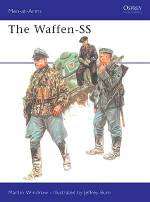 |
Men at
Arms 34
The Waffen SS In the early 1920s, a tiny group was formed within the SA to serve as Hitler's personal bodyguard. Originally labeled the 'Stosstruppe Adolf Hitler', they later became known as the SS SchutzStaffeln, or 'protection squads'. From these humble beginnings, the SS rose to a nominal strength of 38 divisions of over 800,000 men by 1945, representing a sizeable portion of Germany's land forces and more importantly a quarter of her tank forces and a third of her mechanized infantry. Martin Windrow provides a splendid in-depth review of the history, uniforms and insignia of the infamous Waffen-SS. |
Martin Windrow |
||
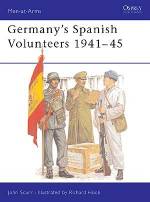 |
Men at
Arms 103
Germany's Spanish Volunteers 1941-45 The Spanish Civil War had been a conflict between the nationalists and conservatives on one side, and what they saw as the opposing anarchic atheistic Marxism which was eroding the traditional Catholic values of Spain. The nationalists eventually won with the aid of Germany against the Soviet backed Marxists, and four years later, the Spaniards seized the opportunity to settle a score with those who had attempted to disintegrate their country. John Scurr's book provides an absorbing account of the organization, campaigns and uniforms of Germany's Spanish volunteers who fought from 1941-45. |
John Scurr |
||
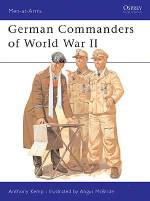 |
Men at
Arms 124
German Commanders of WWII This fascinating study by Anthony Kemp outlines the careers and characters of a number of senior German commanders. To those who read military history many of the names are familiar. It is a paradox, however, that few biographies have been written. The impression still exists today of German generals as stiff-necked, scar-faced, monocle Prussians. Whilst in a few cases this was certainly true, the fact remains that all of them were men, some more ordinary than others. With a variety of photographs, eight full-page color plates by Angus McBride, accompanied by ten pages of commentaries, this is a first-class addition to Osprey's Men-at-Arms series. |
Anthony Kemp |
||
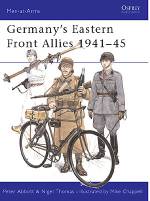 |
Men at
Arms 131
Germany's Eastern Front Allies 1941-45 The 1930s were a time of growing tension for the smaller states of Eastern Europe. Since the end of the First World War they had enjoyed an independence which most of them had not known for centuries, but this was now threatened by the growing power of Nazi Germany and Soviet Russia. Instead of combining for self defense, they were bitterly divided. The Munich crisis showed how little reliance could be placed on the Western democracies, whose power to intervene militarily in Eastern Europe was negligible. In effect this left the smaller East European states with little alternative but to become clients of either Germany or Russia. |
Peter Abbott |
||
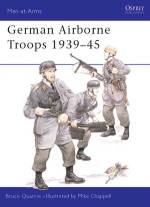 |
Men at
Arms 139
German Airborne Troops 1939-45 Airborne operations have often been called a vertical envelopment, and therein lies one of the best descriptions of their value. The essence of an envelopment is to pin the enemy in place so that it can be destroyed. A strong enemy force to one's rear disrupts supplies and communications and makes one more vulnerable to an attack from the front. It also has a major psychological impact. To an aggressor the value of airborne troops, used properly, far outweighs their numerical strength. Bruce Quarrie's engaging text tells the story of the German airborne troops of the Second World War. |
Bruce Quarrie |
||
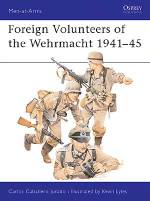 |
Men at
Arms 147 Foreign Volunteers of the Wehrmacht 1941-45 When speaking of the units of foreign volunteers integrated into the German forces during World War II, the Waffen-SS automatically comes to mind. But, in absolute numbers, more foreigners served with the Wehrmacht in the army, navy and air force. Anti-Communism was the most significant reason why so many volunteers were induced to wear the German uniform. This title examines the Wehrmacht’s foreign volunteers, taking a close look at their uniforms, organization and distinctive insignia. Among those covered are the Legion Wallanie, LVF, Ostlegionen, Balkan volunteers, Hiwis, Kalmucks, Cossacks, Baltic, Russian and Ukranian volunteers. |
CC.Jurado | ||
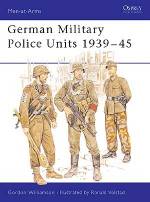 |
Men at
Arms 213 German Military Police Units 1939-45 The military policeman must be one of the least appreciated yet most indispensable military figures in modern history. In the mobile warfare of the 20th century no army could keep its vital supply routes open without the military policeman. This book documents the organization, uniforms and insignia of the many and varied German military police units of World War II. Their duties included traffic control; maintaining military order and discipline; collection and escorting prisoners of war; prevention of looting; disarming civilians; checking captured enemy soldiers for documents; collection of fallen enemy propaganda leaflets and providing street patrols in occupied areas. |
Gordon Williamson |
||
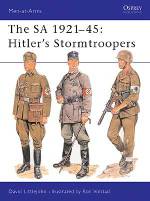 |
Men at
Arms 220 The SA 1921-45 Hitler's Stormtroopers In 1919 Adolf Hitler joined the tiny German Workers' Party (DAP) in Munich, becoming its leader the following year and adding 'National Socialist' to its title. Thus the NSDAP, popularly known as the Nazi Party, was born. All political parties had strong-arm squads to protect their meetings from disruption by rivals, and the NSDAP was no exception. In August 1921 ex-naval Lieutenant Hans Ulrich Klintzsch took command of the NSDAP's 'Defense and Propaganda Troop' which, the following month, was renamed the SA (Sturmabteilung = Storm Detachment). David Littlejohn's fine text examines the history, uniforms and insignia of Hitler's stormtroopers. |
David Littlejohn |
||
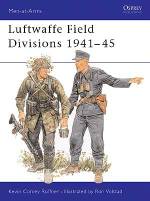 |
Men at
Arms 229 Luftwaffe field divisions 1941-45 Hermann Göring raised the Luftwaffe Field Divisions [LwFD] during 1942, when Nazi Germany was still making spectacular gains but was first feeling the pinch of its losses on the Eastern Front. The Reichsmarschall decided to raise his own divisions for ground service under the command of Luftwaffe officers. On 17 September 1942, Göring called for volunteers from throughout the Luftwaffe for combat duty in the East. Even before that date, however, some Luftwaffe troops were heavily engaged against the enemy in Russia in a ground role. Kevin Conley Ruffner's engaging text tells the fascinating story of the LwFD. |
K.C.Ruffner | ||
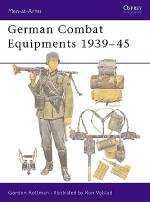 |
Men at
Arms 234 German Combat Equipments 1939-45 The field equipment of the German Army in World War II was closely related to that used throughout World War I and earlier, yet it was of relatively light weight, ruggedly constructed, well designed, functional, and generally of a high quality, though this deteriorated in the later war years. A high degree of design standardization was maintained in most categories of equipment, though materials and their colors often varied widely. There were also many different specializations for the various arms of service as well as theatres of combat, such as the Afrikakorps in the Western Desert. This title investigates all manner of German combat equipments throughout World War II, from belt buckles to magazine pouches. |
Gordon Rottman |
||
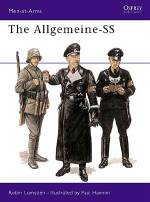 |
Men at
Arms 266 The Allgemeine SS The SS originated as Hitler's personal bodyguard and following his rise to power in 1933 the organization divided into two: the Waffen-SS, which comprised the military wing, and the Allgemeine-SS, whose role was to support the police in maintaining order. The Allgemeine-SS had a wide-ranging effect on all aspects of life in Nazi Germany, from enforcing Hitler’s racial policies through to the running of over 500 factories in Germany and occupied Europe. While the more visible armed SS combat units naturally received all the publicity, especially during the war, it was the rather faceless Allgemeine-SS which wielded the real power. |
Rubin Lumsden |
||
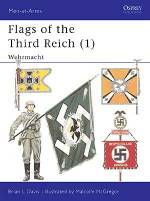 |
Men at
Arms 270 Flags of the Third Reich (I) Wehrmacht The decision to reintroduce unit Colors for the armed forces of the new Wehrmacht involved many problems. No unit flags and standards had been produced since before 1914. Paul Casberg, the well-known master painter and illustrator, was commissioned to design the new Army Colors, a commission which, in his own words, he considered to be 'the most beautiful order I have ever received'. Packed with numerous contemporary photographs, and eight full page color plates by Malcolm McGregor, Brian L. Davis's text examines the flags of the Wehrmacht, in this first of three volumes concerning flags of the Third Reich. Men-at-Arms 270, 274 and 278 are also available in a single volume special edition as ‘Flags of the Third Reich’. |
Brain Davis |
||
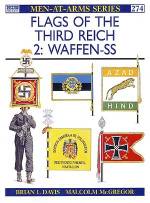 |
Men at
Arms 274 Flags of the Third Reich (II) Waffen SS An essential part of German propaganda was the raising of non-German volunteer contingents, variously named as 'Legions' and 'Free Corps'. These units were from their outset mere token forces, comparatively insignificant in numbers and maintained chiefly for their propaganda value. However, as the tide of battle turned relentlessly against the Germans, the appeal for volunteers became ever more desperate. In this second of three volumes examining the flags of the Third Reich [see Men-at-Arms 270 and 278] Brian L. Davis examines the flags of the Waffen-SS: those of Walloon, Flanders, Norway, Finland, Danzig, Denmark, Estonia, Latvia, Croatia, France, Spain and India. Men-at-Arms 270, 274 and 278 are also available in a single volume special edition as ‘Flags of the Third Reich’. |
Brain Davis |
||
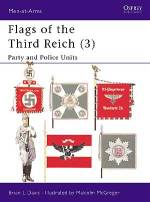 |
Men at
Arms 278 Flags of the Third Reich (III) Party & Police units An essential part of German propaganda was the raising of non-German volunteer contingents, variously named as 'Legions' and 'Free Corps'. These units were from their outset mere token forces, comparatively insignificant in numbers and maintained chiefly for their propaganda value. However, as the tide of battle turned relentlessly against the Germans, the appeal for volunteers became ever more desperate. In this second of three volumes examining the flags of the Third Reich [see Men-at-Arms 270 and 278] Brian L. Davis examines the flags of the Waffen-SS: those of Walloon, Flanders, Norway, Finland, Danzig, Denmark, Estonia, Latvia, Croatia, France, Spain and India. Men-at-Arms 270, 274 and 278 are also available in a single volume special edition as ‘Flags of the Third Reich’. |
Brain Davis |
||